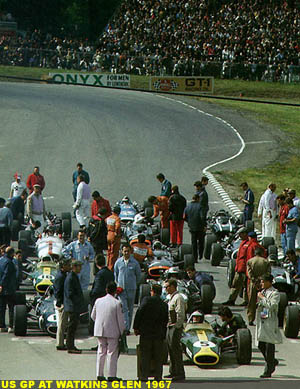|
Every form of racing has its spiritual home: Indianapolis for Indy cars, Charlotte for stock cars, Pomona for dragsters. And for a half-century, sports-car racing has had Watkins Glen, N.Y., host from 1961 to 1980 of the United States Grand Prix Formula One race. "Part of the appeal of the race was the uniqueness of it," said Bob Kelly, who was the track's press chief from 1970 to 1980. "You had this tiny town of 2,700 people in upstate New York hosting a race that was the focus of international attention."
"It's been said, and it's not entirely wrong, that I did it because I had an MG-TC and didn't have a place to race it," Mr. Argetsinger, 77, said by telephone recently. "But the idea was born before World War II, when I got all excited reading about the Vanderbilt Cup races on Long Island." The first races were a success, but with spectators separated from the cars by only a rope in some cases, a serious accident was almost preordained. In 1952, a race car hit and killed a 7-year-old boy. "That could have ended it right there," Mr. Argetsinger said. "But the citizens loved having the race and were determined to keep it going." To do so, the race had to be moved. In 1956, the race committee bought land for a permanent track - what is now Watkins Glen International - on a hilltop west of the village. Watkins Glen International is now owned by the International Speedway Corporation, led by Bill France Jr., Nascar's president. International Speedway and the glass maker Corning rescued the track from bankruptcy in 1983, and the I.S.C. gained full ownership last year. The annual Winston Cup race in August draws many thousands more than the United States Grand Prix ever did. But the Glen and the Grand Prix will forever be stuck together, like the cars that were sucked into the track's once-infamous mud pit, the Bog. Part of the mystique was timing: the race was run the first weekend in October as a final boost for the tourism season. The Finger Lakes foliage and the autumn chill made the experience all the more vivid.
The villagers did more than open their garages to visitors. When I covered my first Grand Prix as a journalist in 1978, I rented a room with a local couple who lived about a half-block off Franklin Street. The village's Norman Rockwell atmosphere did not, however, survive the trip up the hill to the track, with its sometimes rowdy mob of spectators. In 1971, the track was expanded to 3.4 miles from 2.3 miles to satisfy Formula One's demands - and the Bog was born. "When they were moving dirt to build what's now turn 11, they found an underground spring," Mr. Kelly said. What started as an informal challenge among motorcyclists to see who could get through the mud pit without getting stuck soon turned into a competition among junk cars. "And then somebody got their car stuck in there pretty well, and the fans decided in their inebriated wisdom to set it on fire," he added. "Pretty soon you had people going around the infield 'borrowing' other people's cars. I can remember seeing some Corvettes on fire in there." By the late 1970's, the United States Grand Prix was sinking into a financial bog. Bernie Ecclestone was establishing his grip on the Formula One Constructors Association, the dominant team-owners group, and he quickly took aim at the relatively primitive conditions at the Glen. "You couldn't really expect sponsors to want to come," he said in a recent phone interview. Besides the team owners' increasing financial demands, another mounting expense for the Glen was meeting the safety demands of the drivers' association, which seemed to change from year to year, Mr. Kelly said. The track also had no TV revenue and meager corporate sponsorship.
The 1980 Grand Prix was the last at Watkins Glen. "I guess they just forgot to pay us one year," is how Mr. Ecclestone recounted the race's demise. In fact, the Grand Prix corporation was unable to pay and declared bankruptcy in 1981. Formula One has never returned, but the village - which looks much the same as it did in 1948 - and the track have made a cottage industry out of revisiting the era. Watkins Glen International is trying to establish an annual reunion of old Formula One cars in the summer in addition to the schedule of exhibition races for historic competition cars which took place in mid September 1998. The village itself was the site of the Watkins Glen Grand Prix Festival on Sept. 11, including a re-creation of the first races 50 years ago. And the library will dedicate its 6,000-square-foot addition, which will serve as a motor sports research center when it opens next year. The sidewalks along Franklin and Fourth Streets are the Grand Prix Drivers Walk of Fame, with markers honoring stars like Graham Hill, a three-time grand prix winner, and Jackie Stewart. About 2.3 miles from the starting line of the original course, on a granite boulder by the roadside, is a bronze plaque dedicated to Miles and Sam Collier, brothers who drove in the early races. It's at the spot where Sam Collier crashed and was killed in 1950. Their survivors have since moved away from New York State. The road bisects quiet farmland, where it could easily be forgotten - just like a race that took place a half-century ago. But this is Watkins Glen. "Somebody still puts flowers there," Mr. Argetsinger said.
|
| Joseph Siano, The New York Times | COPYRIGHT © 1998 BY THE NEW YORK TIMES COMPANY | ||
| |||


.jpg)
